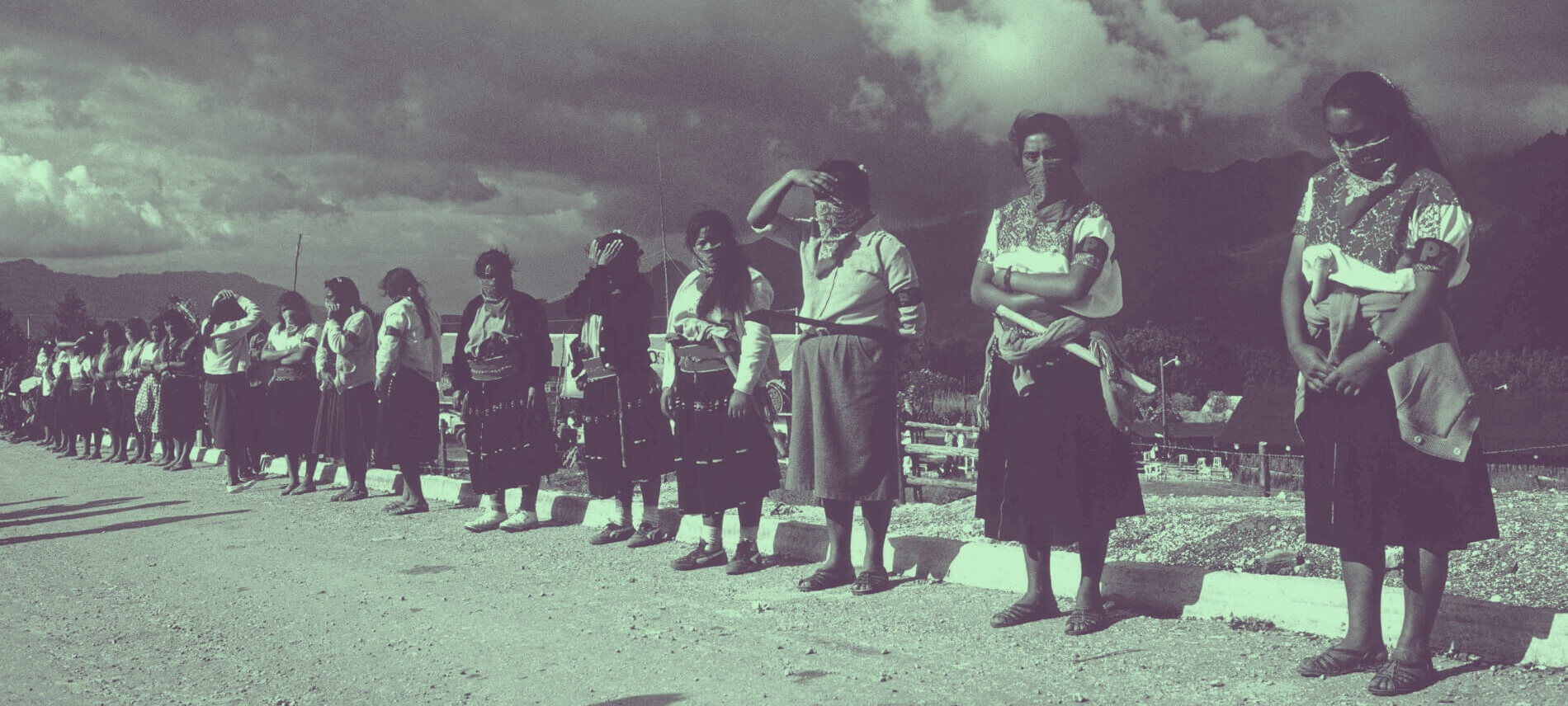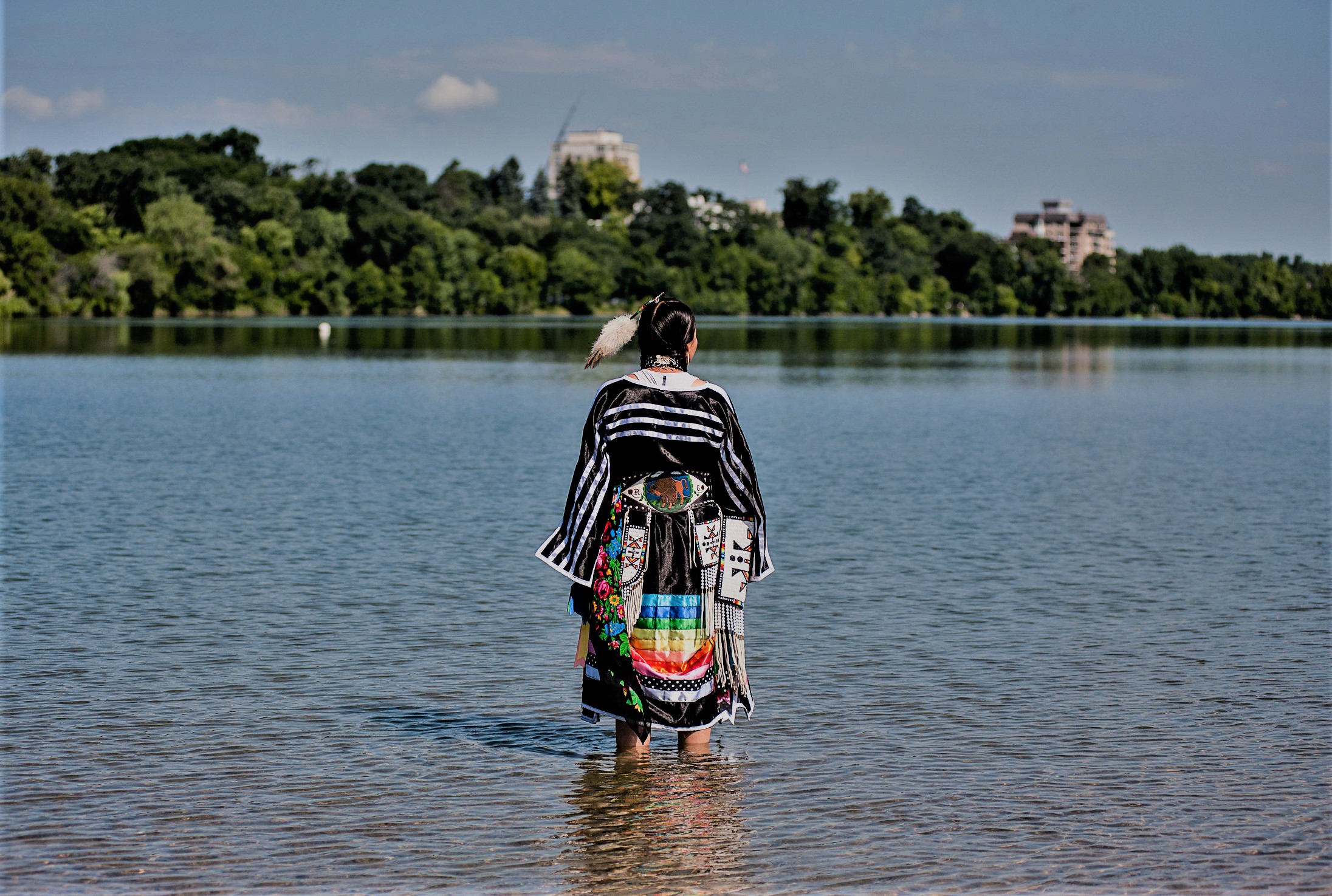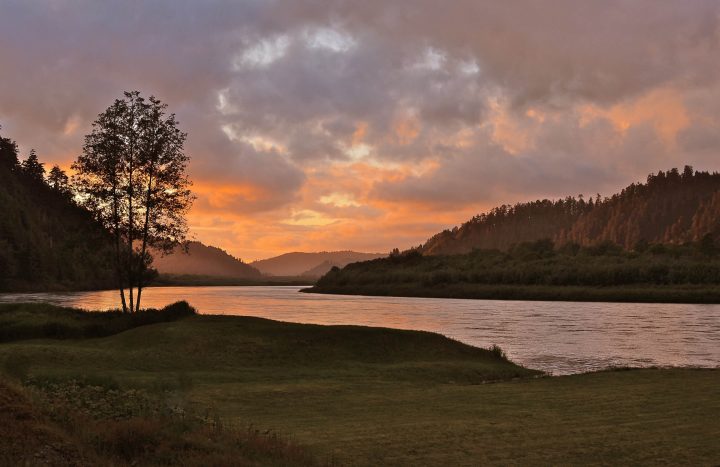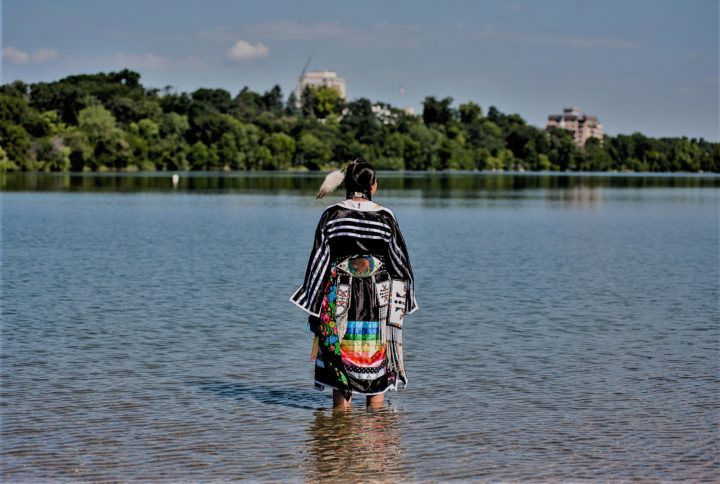
The Indigenous Rights Report is a weekly crash course on everything in the indigenous world.
Make this podcast happen! Support us on Patreon!

In this week’s Indigenous Rights Report:
- Court rules that ‘reasonable’ access to Hawaiian language immersion is a “constitutional right”
- Arctic cruises accused of leaving Indigenous people in the cold
- In New Zealand, young Māori women lead the battle for Indigenous rights
- Thousands of Brazilian Indigenous women protest Bolsonaro’s ‘genocidal policies’
- In Guatemala, Indigenous residents appeal to the President over stolen land
- Malaysia’s Indigenous tribes are trying to lay modern claims to ancestral lands
- Local alliance donates to protect Indigenous land from wildfires
- Indigenous concerns over Muskrat Falls dam not really on the radar
- Advocates for UN declaration of a World Indigenous Peoples Decade of Water build support at Water Summit
- Manitoba First Nations say province hasn’t consulted on proposed flood channel
- Kahnawake elders push back against plans to expand Montreal bridge
- Six communities announce their rejection of a new hydroelectric project in Oaxaca
- NAJA demands The Washington Post retract unreliable data sets and associated reporting
- An Arizona task force will investigate how to combat violence against Indigenous women and girls
- Indigenous communities in Nicaragua at “risk of extinction”
- Indigenous Australians Minister rules out judicial inquiry into Native Title
- International Indigenous People’s Day celebrated in Hpakant
- Commercial fishermen, Indigenous people unite to fight mine in Alaska
- Yuendumu in Central Australia at ‘severe risk’ of running out of water
- At-risk Indigenous languages spotlighted on new Google Earth platform
- Center for American Indian Health expands to Upper Midwest
- The Indigenous movement, once a champion for the rights of Nepal’s Indigenous peoples, is losing steam
- State’s tribes seek accurate Census count
Hawaii’s Supreme Court has ruled that its state constitution guarantees “reasonable access” to Hawaiian language immersion programs, which is characterized as a necessary component of restoring the island’s indigenous language and, ultimately, the culture. The case was brought by the parent of two schoolchildren on Lanai. The only public school on the island has not been able to build a Hawaiian language immersion program. House finance committee chair Sylvia Luke says implementation will be difficult and recruiting and retaining teachers on Lanai is a struggle because of the island’s high cost of living.
The state Department of Education launched its Hawaiian Language Immersion Program in 1987. Instruction is only in Hawaiian through grade 5, at which point English is introduced.
Indigenous communities far up north are being “overwhelmed” by ships that drop up to 1,000 passengers in small villages but offer no employment opportunities, said Kuupik Vandersee Kleist, an advisor to the Inuit Circumpolar Council. Large cruise ships also carry a heavy environmental burden, according to the Friends of the Earth charity, which said the vessels created large amounts of human sewage, oily bilge water and hazardous waste.
The number of global ocean cruise passengers rose from 17.8 million in 2009 to 28.5 million in 2018, according to research by the Cruise Lines International Association, an industry body.
Thousands of protesters occupying the land at Ihumātao are part of a number of grassroots movements spearheaded by young, educated and tech-savvy Māori women. Using social media and crowd-funding websites, the groups are mobilizing community support to demand land rights and other reforms for Māori in the highest profile indigenous rights campaigns in more than a decade. In another demonstration, thousands marched in the capital Wellington protesting the removal of at-risk Māori children from their families. The issues have become proxies for a wider discontent among young Māori about modern New Zealand, and disenchantment with the government which some say has done little to break cycles of poverty and violence.
Māori, who account for about 15% of New Zealand’s population, were dispossessed of much of their land during colonization by Britain in the 19th century.
Thousands of indigenous women marched on Brazil’s capital denouncing the “genocidal policies” of far-right President Jair Bolsonaro, who faces growing criticism over the destruction of the Amazon. Bolsonaro wants to open the rainforest to industries by allowing more mining and farming in the region. Experts and activists have warned such policies will have devastating environmental impacts on Amazon (often called “the lung of the Earth”), particularly in worsening climate change.
Brazil’s government has demarcated hundreds of territories since the 1980s for the exclusive use of its 800,000 Indigenous inhabitants. Access by outsiders is strictly regulated.
Indigenous Maya Mam residents of Cajolá, Quetzaltenango, have demanded compensation for stolen land. Maya Mam communal lands were originally dispossessed from the community of Cajolá by the Guatemalan government in 1910 during the dictatorship of Manuel Estrada Cabrera, and were distributed to military officials. Residents began to demand the return of their land during the 2012-2015 administration of Otto Pérez Molina. But the administration never followed through on the agreement it made with residents. According to Eduardo Jiménez, from the migrant advocacy Cajolá Group, at least 30 percent of the population of Cajolá has migrated to the United States; the root causes generating the migration are “poverty caused by not only the dispossession of land, but also military repression during the thirty-six years of war and lack of access to health care and education.”
While Indigenous peoples in Guatemala continue to suffer from severe inequality, the Trump Administration pushes for a “safe third country” agreement, which will require asylum seekers to apply in Guatemala. Activists and residents in Guatemala continue to reject the agreement.
One of the largest tribes in the northern part of Peninsular Malaysia i s fighting to obtain rights to over 12,465 hectares which they claim to be ancestral forests. Several Temiar villages this year erected blockades to prevent a logging company from accessing forests — part of the Air Cepam Forest Reserve in the Perak state — that the local government has granted permission to cut. In Perak, the first records of Indigenous peoples opposing logging on their ancestral lands date back to 1937. For more than 80 years, Malaysia’s Indigenous tribes have tried to lay modern claim to lands their people have lived on for centuries. The rapid development of Malaysia during the last few decades — which has includedintensive logging, expansion of palm oil plantations and other large scale agricultural crops — have rendered Indigenous tribes as one of the most vulnerable communities in Malaysia. Currently, most of the forests that they depend on for their livelihoods are owned by the Malaysian government; only a few areas are recognized as ancestral forests belonging to the Indigenous tribes, and these areas were obtained through legal suits against local governments.
In peninsular Malaysia there are 18 officially recognized Indigenous tribes.
The Western Klamath Restoration Project awarded 5-million dollars from California’s Climate Investments Statewide Program to kick start the Somes bar integrated fire management project to help protect historically Indigenous land from wildfires. The Somes project includes 55-hundred acres populated and utilized by Indigenous Karuk people.

Sunset On The Klamath River. Photo: Linda Tanner/flickr. Some Rights Reserved
The statewide program puts billions of dollars to work to reduce greenhouse gas emissions, strengthen the economy and improve public health and the environment.
Nalcor Energy started impounding water behind the dam at the Muskrat Falls hydroelectric project. The stored water puts a final and permanent halt to any chance of mediation measures like wetland capping to prevent the release of methylmercury. This is just one example of the company’s unfulfilled promises. If there was a conflict between promises to Indigenous groups and Nalcor’s scheduling needs, Nalcor’s schedule regularly won out.
Several First Nations in Manitoba say they haven’t been consulted by the province on plans for a new flood channel connecting two major waterways to mitigate flooding risks. At the Interlake Reserves Tribal Council (IRTC) in Ashern some said plans for the proposed Lake Manitoba-Lake St. Martin channel outlet project could negatively impact First Nations rights. The provincial government has been working on plans for the channel since major flooding devastated First Nations communities in the province eight years ago.
The IRTC represents six communities in the Interlake region of Manitoba, including the four that were impacted by the 2011 flood.
Advocates for the U.N. declaration of a World Indigenous Peoples Decade of Water partnered with local organizations to drum up grassroots support at the Mni Ki Wakan (Water is Sacred) Summit in South Dakota. The third such summit of its type, it was held in partnership with “Indigenous peoples, youth, and allies working to develop collective innovations and transformations dedicated to the future of water,” organizers said.

This photo is posted by organizers gathering local support in the Black Hills area for global resistance to the Keystone XL Pipeline across Ft. Laramie Treaty lands. COURTESY / Mni Ki Wakan
Addressing the Expert Mechanism on the Rights of Indigenous Peoples, EMRIP on July 18, Wakinyan Skye LaPointe, Sicangu Lakota, spoke on behalf of the Mni Ki Wakan delegation members to explain their cause, stating, “Today our waters are threatened… The TransCanada Corp. is working to construct the KXL Pipeline in violation of the 1851 and 1868 Ft. Laramie treaties of the Oceti Sakowin, Seven Council Fires, otherwise known as the Great Sioux Nation, placing the very future of our sacred water into jeopardy. We urge EMRIP and relevant U.N. agencies to support Indigenous peoples to stop the Keystone XL Pipeline.”
Talk of more construction, and possibly an expansion of the Mercier Bridge, has become a considerable source of tension among Kahnawa’kehró:non. And no one seems to have a straight answer about the possible toll that a new or improved bridge will have on a community. Longhouse Elder Kenneth Deer spoke out on behalf of his cohorts at the Kahnawake 207 Longhouse – the community’s proponents of traditional leadership – saying they disagree with the lack of transparency and overall handling of the project. “Yes, we need a new bridge, but we’ve got to find a way of doing it without self-destroying any of our land,” he added. Deer says in the wake of the construction announcement, there are increased concerns for animal and plant life above the Saint Lawrence’s surface as well.
The Mercier Bridge connects the island of Montreal to the Mohawk community on the south shore and is a crucial thoroughfare for Montrealers with an estimated 75,000 commuters using the bridge every day.
Several communities from the Southern Sierra and coastal regions of Oaxaca held a press conference to announce their rejection of a new hydroelectric project that is being promoted by a private company on the Río Verde. Authorities of six Indigenous and farming towns questioned the campaign promises of Mexican president Andrés Manuel López Obrador to respect Indigenous rights and protect the environment. Meanwhile, the Council of Peoples United in Defense of the Río Verde (Copudever) vowed to continue their 12-year struggle against the damming of their river, which has been protected by a legal injunction since January of this year.
In a statement, communal and municipal authorities affirmed that “throughout our life as Peoples we have coexisted with, cared for and defended the Río Verde, because it is the mother of our waters and represents a source of life in this watershed and in our Mixtec, Chatino and Afro-Mexican territories.” They notified Semarnat and the company GENERACIÓN ENERSI S.A. de CV. that they will not allow preliminary studies for the hydroelectric project nor its construction, “due to the serious effects that this would bring to our lives and to mother nature.”
The Native American Journalists Association (NAJA) condemned The Washington Post for publishing materials that ignore facts, promote discrimination and undermine legally-established rights and protections for Indigenous peoples. NAJA encourages The Washington Post to consider how its reporting contributes to racism in the United States.
NAJA is one of many organizations that advocates for the retirement of racialized mascots and the application of journalistic ethics when reporting on them. It is the position of NAJA that persistent, irresponsible reporting on racialized mascots and team names is unethical and harmful to Indigenous peoples.
Starting August 27, an Arizona task force will investigate how to combat violence against Indigenous women and girls. Jennifer Jermaine, the Chandler Democrat who sponsored House Bill 2570, said the 21-member task force was gearing up to study the scope of the “epidemic crisis.” “Four in five American Indian and Alaska Native women have experienced violence in their lifetime, and in some communities across the U.S., the murder rate of Indigenous women is 10 times the national average,” Gov. Doug Ducey said at the signing.
The task force is expected to include tribal government members, victim advocates, tribal police, social workers and Indian Health Services leaders, among others.
Miskito communities in Nicaragua could be on the verge of extinction as they continue to face abandonment and vulnerability because of the constant invasion of their territories, according to reports from the Center for Justice and International Law (CEJIL). Lottie Cunningham, president of the Center for Justice and Human Rights of the Atlantic Coast of Nicaragua (CEJUDHCAN), affirmed that there is “a humanitarian crisis because of the increase in occupation by settlers in Indigenous territories”.

Secretary of the YATAMA Council of Elders sits with a grieving Miskito elder at the grave of a community hero who died fighting to protect the land and people. Photo: Courtney Parker, Intercontinental Cry, 2016
The communities and the study request the State to investigate, prosecute and punish those responsible for committing human rights violations to Indigenous Miskito (Mískitu, in the Miskito language) communities.
Australia’s federal government says it has no plans for a royal commission into native title “at this time”. This comes after calls for an inquiry by Adnyamathanha peoples including Port Augusta-based Charlie Jackson and Gladstone’s Enice Marsh. Mr. Jackson is chairman of the Aboriginal Reform Group that challenged the Adnyamathanha Traditional Lands Association to hold a general meeting so that royalty payments from Beverley uranium mine could be clarified. Indigenous Australians Minister Ken Wyatt’s office pointed to plans to increase accountability and transparency of Native Title corporations. Mr. Wyatt’s spokesman said that “The recognition and exercise of native title rights contributes to economic, social and cultural improvements for Indigenous people.”
About 2,000 Adnyamathanha are in the north of South Australia, mostly living in Port Augusta.
The Kachin Indigenous People’s Protection Committee (Mungnawk Hkawng Uru Rudi Ruhpang Ga in the Kachin language Jinghpaw) celebrated International Day of the World’s Indigenous People in Hpakant town on August 9. An organizer, Lamawng La Tawng, said that the purpose of the event was to let migrants from other parts of Burma know about the existence of Indigenous peoples in Hpakant, a jade-mining area. “We also want indigenous people to try to reclaim their lost rights.”
In a statement, the Kachin Indigenous People’s Protection Committee said that “government should inform, discuss and get an agreement with Indigenous people before starting development projects, business projects and seeking natural resources projects because these things are stated in the Ethnic Rights Protection Law, Chapter 4, Article 5”.
In the village of Dillingham in southwestern Alaska, Indigenous peoples have United with commercial fishermen against a potential mining project that they believe would devastate their way of life. The Pebble Mine is a large deposit of gold, copper and molybdenum located at the headwaters of Bristol Bay. Those who want to develop the mine say it will create high-paying jobs for locals and reduce America’s dependence on foreign countries for the provision of raw materials. Opponents say toxic discharge from the mine could foul the home of the world’s largest salmon run, bankrupting the mammoth fishing industry and destroying the local ecology.
Last month, the Environmental Protection Agency (EPA) announced it would withdraw a previous scientific determination that blocked development of the mine. Both groups also believe EPA’s recent decision that could allow the mining project to move forward was politically motivated.
The largest remote Aboriginal community in Central Australia is rapidly running out of drinking water. Frustrated residents said the Government was not treating the issue as urgent, and communication with locals about potential plans had been poor. Locals say the community of Yuendumu, with a population of roughly 900 people, desperately needs new infrastructure. But the Northern Territory Government did not give approval for the new construction in the community to prevent added pressure on the dwindling potable water supply.
A letter from the NT Minister for Essential Services Dale Wakefield to the local Independent MLA Scott McConnell sent in May this year said Yuendumu was listed as a community at “severe risk” in relation to its water supply.
Google Earth has launched an interactive platform on its Voyager feature that lets users listen to audio recordings by more than 50 Indigenous language speakers from across the globe. Titled “Celebrating Indigenous Languages”, the project spotlights diverse communities and profiles of pioneering activists who are fighting to preserve their ancestral languages.
The new Google Earth project coincides with a United Nations initiative that has declared 2019 the “Year of Indigenous Languages,” which similarly seeks to bring attention to the world’s disappearing tongues. Of the 2,680 international languages that are considered at risk, most are Indigenous, according to the U.N. Assimilation, political persecution and globalization are among the causes of dwindling language diversity—a phenomenon that is occurring at an alarming rate. It has, in fact, been estimated that a spoken language disappears every two weeks.
Building on community partnerships with tribal members from 11 Ojibwe Bands, the Johns Hopkins Center for American Indian Health will expand its programming to the Midwest to reach more than 125 tribal communities in 20 states. It offers a range of programs that center on holistic approaches to health, such as alcohol and drug abuse prevention, maternal and child health, mental health, and obesity and diabetes prevention. The center’s new Great Lakes hub will be located in Duluth, Minnesota, and will be home to a study examining a multigenerational approach to preventing diabetes in American Indians.
Since 1991, the center, which is based in the university’s Bloomberg School of Public Health, has worked with American Indian and Alaska Native communities to improve the health status, self-sufficiency, and health leadership of native people. In the U.S., American Indian youth experience the highest rate of childhood obesity and the highest and fastest-growing rate of Type 2 diabetes of any racial or ethnic group.
Members of Indigenous communities in Nepal marked the International Day of the World’s Indigenous Peoples by shining a spotlight on how, despite various political changes, the Nepali state has continued to remain exclusionary. But Nepal’s Indigenous movement of late, especially after the promulgation of the constitution, has taken a back seat. Shankar Limbu, an activist who is also a lawyer associated with the Lawyers’ Association for Human Rights of Nepalese Indigenous Peoples, agrees that there is a need for a nationwide movement if the Indigenous peoples of Nepal were to push the government to address their concerns and demands.
Nepal’s Indigenous population constitutes 35.8 percent of the total population. But historically, their representation in the state organs has been dismal.
In Massachusetts, with the 2020 Census less than a year away, state officials and tribal leaders have been organizing efforts with hope of getting a more accurate tally. John “Jim” Peters, executive director of the Massachusetts Indian Affairs Commission and a member of the Mashpee Wampanoag, said his office is working with tribal leaders on outreach to the Native American community to encourage participation. For the state’s two federally recognized Wampanoag tribes — the Mashpee and Gay Head on Martha’s Vineyard — there’s more at stake than just an accurate head count. While the threat of an undercount puts the state at risk of missing out on federal funding for health care, roads and schools, tribal nations risk missing out on federal dollars for housing and employment training programs. The federal government distributes more than $1 billion a year to recognized tribes, according to the National Congress of American Indians.
Massachusetts is considered one of the most difficult states to count Indigenous persons, with 33% living in hard-to-count tracts, according to the federal data. Native Americans weren’t counted as part of the U.S. Census until the late 1800s. Indigenous people living on reservations were undercounted by more than 5 percent during the last decennial count in 2010, according to the Census Bureau, the highest among any racial or ethnic group.
This is the Indigenous Rights Report.

Indigenous Peoples are putting their bodies on the line and it's our responsibility to make sure you know why. That takes time, expertise and resources - and we're up against a constant tide of misinformation and distorted coverage. By supporting IC you're empowering the kind of journalism we need, at the moment we need it most.